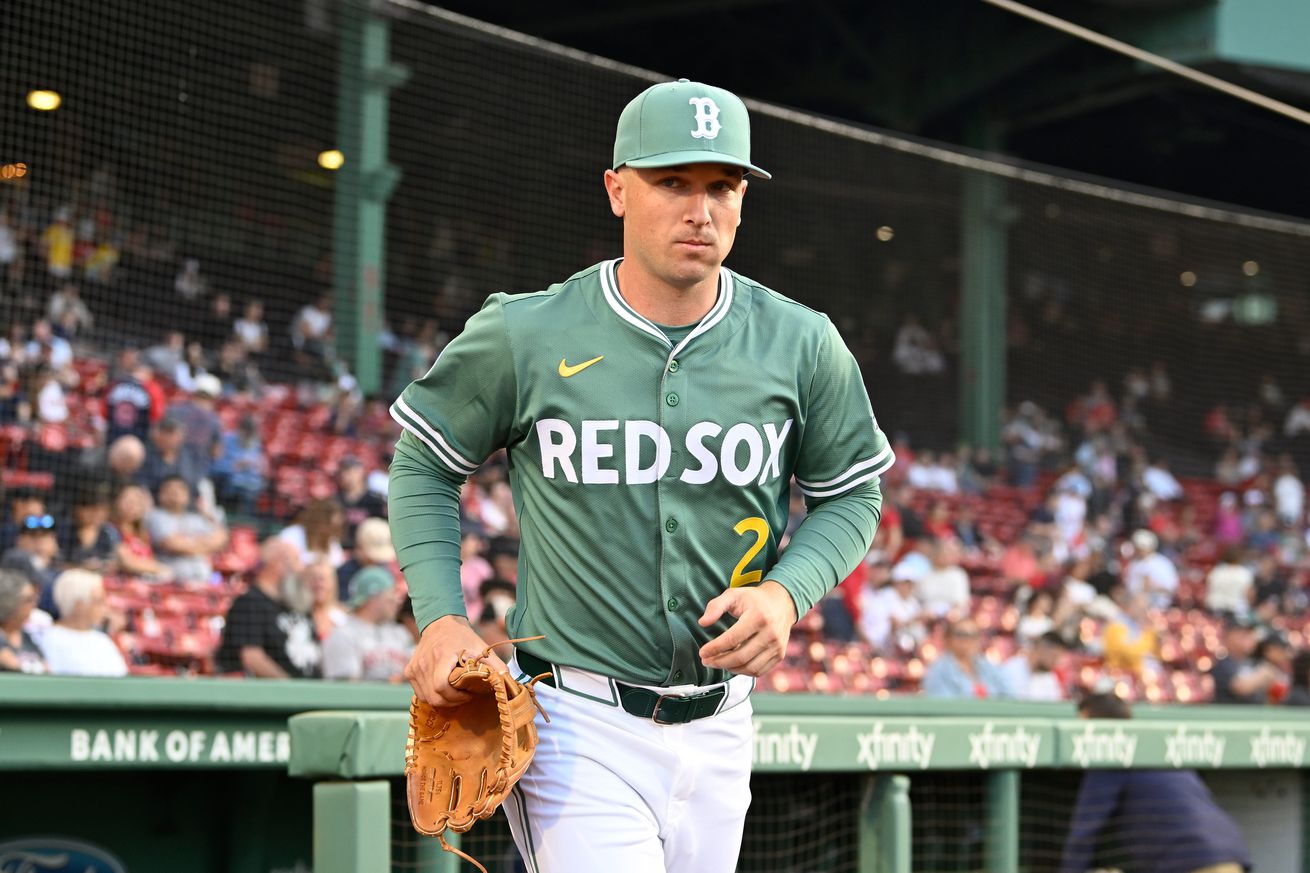
As the Red Sox return to full health, what should their lineup look like going forward to make the most of the second half of the season?
As Boston’s roster becomes increasingly crowded with the return of Masataka Yoshida and Alex Bregman, I thought it would be a good time for me to take my third shot at optimizing the Red Sox lineup. Back in 2023, I tried to optimize the lineup based on research from Tom Tango’s The Book, with a specific focus on finding a leadoff hitter for a Red Sox club that was pretty much throwing things at the wall and seeing what might stick.
This year, Boston has possibly an overload of top-of-the-lineup batters. But it’s always interesting to look at an optimized version of a lineup because, in doing so, a team can squeeze out an extra four or five wins over the course of the season, a welcome advantage for a team this streaky. With some tough decisions looming large this week, it’s a good time to see how to get the most out of a team that seems to be finding its identity just past the halfway point of the season. This year, I changed some things up and decided to create a lineup for LHP starters, RHP starters, and just in general, considering the platoon-heavy lineup that Boston has trotted out as of late.
Although there are plenty of stereotypes in baseball surrounding the idea of building a lineup, sabermetrics and recent advances in lineup optimization research over the past two decades have initiated a new area of development and set new standards throughout the big leagues (in some cases). One of these non-digital advances is Tom Tango’s The Book. Originally published in 2006, The Book includes a hefty chapter on lineup optimization that looks at factors such as DP rate, baserunning, wOBA, and other statistics and game factors that can be used to build an optimal lineup. The majority of my research has come from this chapter of The Book, and I’ll explain a couple of important points a bit further before we get to applying the concepts to the 2025 Red Sox.
In general, the No. 1 hitter will get 2.5% more plate appearances per game than the No. 2 hitter and so on and so forth down the entire lineup. Because of this, each batting slot has 2.5% more of an effect on the outcome of the game than the following slot. Of course, this isn’t the only — or even most important — factor, meaning that your best hitter shouldn’t necessarily be placed in the leadoff spot. A confounding variable emerges when we think about the 24 base/out states that are possible in baseball (e.g., a runner on first with no outs, bases loaded with two outs, etc.).
This leads us to two important charts, which show the frequency with which a lineup spot sees a base/out state (not combined, and all whole numbers are per game).
All data in these tables are based on AL numbers only, since The Book was written in 2006 and isn’t quite as interested in factoring pitchers’ batting numbers into lineup optimization.
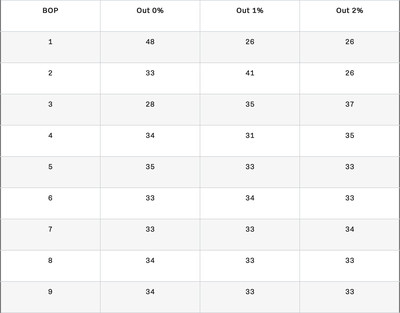
Tom Tango
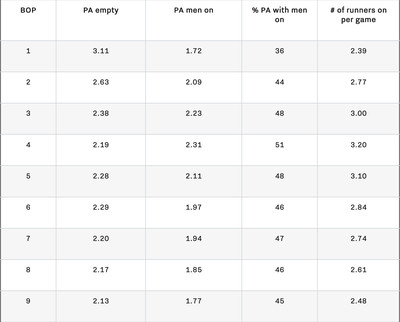
Tom Tango
By looking at these two tables, we can begin to understand how confounding factors throughout the game affect a lineup and, in turn, the kind of hitter you’d want to have in a certain spot. That leads us to the Big Daddy of all tables, which is initially overwhelming to look at, and combines all the data from these previous tables into one that gives the Run Expectancy (RE) for each event in each lineup spot. Run Expectancy measures the expected runs caused/created by an event. So, for example, a double by the No. 2 hitter would, on average, result in .799 runs for a team when considering the men that may be on base, the number of outs there may be, and the PA factor of the lineup spot.
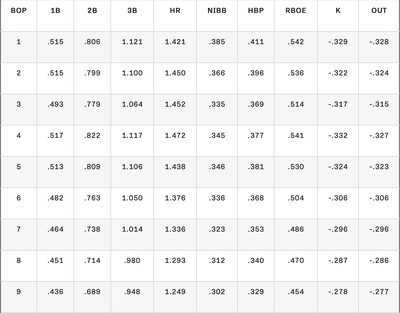
Tom Tango
With these overarching factors in mind, I’ll explain a couple more position-specific correlations/tendencies before diving into what this year’s lineup should look like to maximize Boston’s output for the rest of the year.
No. 2 and No. 4 Hitters
The No. 4 hitter has an advantage in all XBH categories, but the No. 2 hitter has an equal advantage in NIBB and HBP. This means that the No. 4 and No. 2 hitters should be relatively equal in performance as a whole, but the cleanup man should post a better SLG%/ISO, while the No. 2 hitter should provide more consistent on-base numbers.
Another thing to keep in mind with this is that the No. 2 hitter will have 5% more plate appearances than the four-spot batter, but on average, the No. 4 hitter will be up with more men on base, which is important when considering the XBH advantage.
No. 2, No. 3, and No. 4 Hitters
In the middle of what should be two similar players in the No. 2 and No. 4 spots is the No. 3 hitter. Nearly every event favors the No. 2 hitter by 0.02-0.03 runs, while the No. 4 hitter also has an advantage in RE across the board. This means that the No. 3 hitter should be a worse hitter than both the No. 2 and No. 4 hitters.
No. 3 and No. 5 hitters
The No. 5 hitter has a 0.03 RE advantage on singles, doubles, triples and NIBB, while the No. 3 hitter has the 0.02 RE advantage on the HR. This makes every out for the No. 5 more costly than the same out in the No. 3 spot. Because of this, the No. 5 hitter should actually be better than the No. 3, but, ideally, the better home run hitter should be in the three-spot. The home run is more valuable for the No. 3 hitter mostly because they’re more likely to be up to bat with two outs, making a single event to produce a run (no matter the other game circumstances) increasingly useful.
Nos. 6 through 9
From here on, things get a bit simpler, as each batter 6-9 has lower RE values entirely than the slot above it. So, for these final three spots, it should really just be a decrease in offensive talent as you move down the line.
No. 1 hitter
The No. 1 hitter finds its greatest RE advantage in walks and its biggest disadvantage in home runs. Because of this, the No. 1 hitter should be similar in talent to the No. 2 hitter but with better plate discipline.
Strikeouts And Their Effects On Optimization
As far as strikeouts and their effect on the game go, the three, four, and five spots are on opposite ends of the spectrum. Because of this, you want your best hitter with the most strikeouts in the three-spot, so as to maximize run value. This is because when the No. 3 hitter strikes out, it has less effect on the game than if the No. 1, 2, 4, and 5 spots were to do the same.
Additionally, it is best to put a low strikeout hitter in the fourth and fifth slots, where strikeouts have some of their most costly values due to common base/out states.
Double Play Tendencies Throughout A Lineup
Double play (DP) situations per game, relative to league average by batting order, are important to consider when building a lineup: especially in the No. 3 (0.18 DP situations/game) and No. 5 (0.02 DP situations/game) spots — where the numbers of DP/game are at their separate extremities. For this quantification within the Red Sox lineup, I evaluated DPrate, which rates a player’s tendency to hit into double plays relative to league average (so far, this season’s league average DPrate is 8.5%). The player with the best DPrate should be placed third, as they are less likely to GIDP, while the best player with the worst DPrate should be fifth, where they experience fewer chances to hit into a double play. I calculated this value for each main Red Sox hitter in 2025:
Baserunning and basestealing
One final point of importance before we get to applying these concepts to the Red Sox: baserunning and basestealing. As Tango explains in The Book, baserunning and base stealing end up canceling each other out when trying to build a lineup to favor individual base stealing and baserunning. To better explain this, here is a quote from The Book itself:
“A great baserunner is usually, but not always, a great basestealer. …[Y]ou would prefer to steal a base, and get into scoring position, as long as you have a hitter that hits a lot of singles, but not many extra-base hits. This is the reason we want our basestealer to bat fifth or sixth. At the same time, you prefer to have your great baserunner in front of hitters that hit a lot of singles [in order to optimize their value], regardless of their power numbers. This is the reason we want them at the top of the order.”
Essentially, this creates a paradox where we are trying to put the same person— one that is a good baserunner and base stealer— into opposite positions in a lineup, which is why worrying about speed in its different aspects is a bit of an insignificant factor to consider when optimizing a lineup.
With all the factors that go into lineup optimization, it’s almost impossible to consider every factor that is an advantage or disadvantage to a certain spot in the lineup because it’d have you placing hitters in conflicting positions. (e.g.: consistency is important in the No. 2 spot because of their high PA factor, but what if your most consistent hitter is also your most powerful hitter, and should therefore be placed in the No. 4 spot to maximize the effectiveness of the long ball?). But just for context, here’s what Tango has for what an optimal lineup should look like.
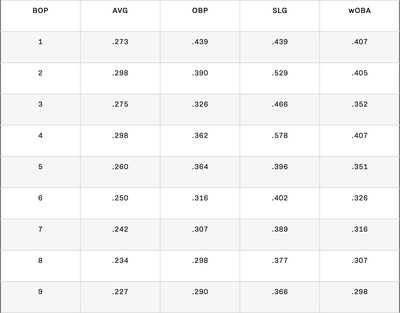
Tom Tango
Obviously, the talent assumed across this lineup is relatively hard to find in today’s game, but it is helpful for building what would be best when you may have conflicting factors because of a player’s style of play.
So, finally, with all this data in mind, let’s see how it should apply to the Red Sox, shall we?
Since I know this whole thing was a lot to even get to this point, here’s a general breakdown to keep in mind:
- 1 (more walks) ≈ 2 (overall consistency) ≈ 4 (more power, fewer strikeouts)
- 3 (most strikeouts, lower DPrate) < 2, 4 and (because of that) 1
- 5 (better OBP, fewer strikeouts, higher DPrate) > 3 (more power)
Since the platoon approach has been pretty heavily used this year, I’ll be positing an optimized lineup against LHP, RHP, and in general.
Now, let’s get to the optimized Red Sox lineups
The Optimized LHP Lineup
In which we all get to bask in the glory of leadoff Rob Ref for a bit longer!
- Refsnyder DH
- Bregman 3B
- Story/Gonzalez SS/1B
- Abreu RF
- Gonzalez/Story/Anthony 1B/SS
- Anthony/Gonzalez LF
- Narvaez C
- Rafaela CF
- Mayer 2B
Why?
Refsnyder serves as your almost picture-perfect leadoff hitter with OBP and AVG, and Bregman provides you consistency in the No. 2 spot (he’s slashing .370/.500/.500 against lefties this year). Story and Gonzalez are interchangeable at Nos. 5 and 3 for me. Story would be mostly preferred in the three-spot because of his HR abilities, but Gonzalez could be argued to switch to there from the No. 5 due to his low DPrate, which would place him in the most likely spot to hit into a double play. Abreu claims the No. 4 spot mostly due to his power numbers and Bregman’s OBP being much higher.
OR
- Bregman 3B
- Story SS
- Yoshida DH
- Abreu RF
- Anthony LF
- Gonzalez/Toro 1B
- Narvaez C
- Rafaela CF
- Mayer 2B
Why?
While I strongly believe Refsnyder should be in there on days versus LHPs, the overcrowded roster complicates things just a bit, so that’s an alternative lineup in case you’re hell-bent on getting Yoshida in there.
Bregman is a great leadoff man if Refsnyder isn’t in there for whatever reason because of his consistency and OBP, while Story moves up one. Yoshida overtakes Anthony in the No. 3 spot for his HR numbers, pushing the 1B tandem out of the top 5 spots.
The Optimized RHP Lineup
Without really having to throw Refsnyder in the DH mix, Boston’s optimal lineup against righties is a bit simpler, but makes the outfield more crowded:
- Duran LF
- Toro 1B
- Story/Bregman SS/3B
- Abreu/Anthony RF
- Bregman/Story 3B/SS
- Yoshida DH
- Narvaez C
- Rafaela CF
- Mayer 2B
Why?
Duran is a less-hot Refsnyder against righties, which slots him in perfectly at the leadoff spot. Toro’s OBP makes him the best consistent option for No. 2, while Story and Bregman are interchangeable at the 3/5, mostly depending on who has the higher SLG% or HR numbers. Taking out an outfield spot, it’d be Abreu and Anthony switching off at No. 4 and out in right field.
And finally, the generic, split-less, simple lineup that is usable across games, but mostly strips us of the joy of watching Rob Refsnyder play baseball:
- Bregman 3B
- Anthony LF
- Story/ SS
- Abreu RF
- Yoshida DH
- Narvaez C
- Gonzalez/Toro 1B
- Rafaela CF
- Mayer 2B
Why?
While slotting in at No. 2 or No. 3 spot in the platoon lineups, Bregman’s overall stats make him the perfect candidate for the leadoff spot with the highest OBP on the team and a .402 wOBA. Anthony moves up to the two-hole due to his ability to reach base and Story’s HR advantage (for the time being), while Yoshida claims the No. 5 spot as a well-rounded hitter. Abreu remains fourth for his power, while Narvaez overtakes the first-base platoon in a general lineup.